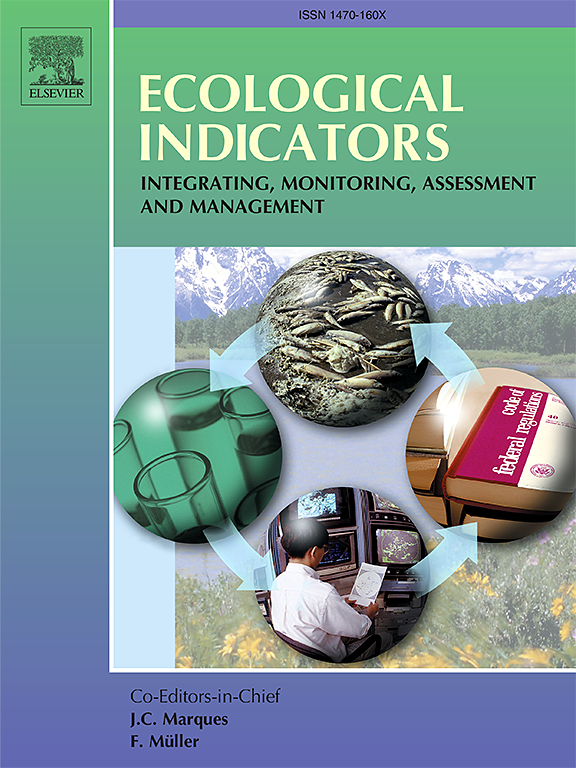Accuracy and applicability assessment of vegetation types of the land cover products produced in China
IF 7
2区 环境科学与生态学
Q1 ENVIRONMENTAL SCIENCES
引用次数: 0
Abstract
Highly accurate land use/land cover (LULC) information is crucial for monitoring current environmental changes. The existing LULC products generated based on Landsat, MODIS, Sentinel, and other remote sensing images have obvious differences in classification accuracy, spatial and temporal resolution, the applicability, and the stability of the time series products in different regions. The accuracy and applicability assessment of LULC products in China is predominantly concerned with the comparative analysis of area and spatial distribution characteristics of single temporal data, while the assessment of vegetation types in the spatial and temporal dimensions is seldom involved, resulting in the applications of these products in forest resource monitoring and ecological value evaluation at national and regional scales remaining unclear. Therefore, we analyzed the applicability of three land cover products produced by Chinese institutions, including 35 issues of CLCD, 3 issues of GlobeLand30 and 10 issues of GLC_FCS30D, in terms of temporal stability and spatial consistency, and developed a spatial accuracy assessment method to realize the spatial accuracy mapping of different land cover products using the multiscale geographically weighted regression model (MGWR). The results show that with respect to temporal stability, the CLCD product has high stability in forests and grasslands and is suitable for monitoring long-term changes; the GLC_FCS30D product has obvious advantages in the stability of shrubland types and local feature recognition; the vegetation type stability of the GlobeLand30 product reaches more than 0.85, but is limited by the short time series data. With respect to spatial consistency, the GLC_FCS30D product shows better overall spatial consistency than the CLCD and GlobeLand30 products, the fineness of vegetation type delineation is correlated with the level of spatial consistency, and there are obvious geographic differences in spatial expression between different products. The three products have different levels of ambiguity in distinguishing the boundaries of forests, shrublands and grasslands. The CLCD product has the highest overall spatial accuracy, with local spatial accuracy variations in the north, southeast, and southwest in China, and users who are concerned about these regions should be aware of the differences between the products. This study provides a reasonable basis for Chinese users to make appropriate selections of land cover products or to integrate different products according to application scenarios.
中国土地覆被产品植被类型的准确性和适用性评估
高度精确的土地利用/土地覆盖(LULC)信息对于监测当前的环境变化至关重要。现有基于Landsat、MODIS、Sentinel等遥感影像生成的LULC产品在分类精度、时空分辨率、时间序列产品在不同区域的适用性、稳定性等方面存在明显差异。中国LULC产品的准确性和适用性评价主要集中在对单一时间数据的面积和空间分布特征进行比较分析,而在时空维度上对植被类型的评价较少,导致这些产品在国家和区域尺度上森林资源监测和生态价值评价中的应用尚不明确。为此,本文对35期CLCD、3期GlobeLand30和10期GLC_FCS30D 3种中国机构土地覆盖产品在时间稳定性和空间一致性方面的适用性进行了分析,并建立了基于多尺度地理加权回归模型(MGWR)的空间精度评价方法,实现了不同土地覆盖产品的空间精度映射。结果表明:在时间稳定性方面,CLCD产品在森林和草原具有较高的稳定性,适合监测长期变化;GLC_FCS30D产品在灌木林类型稳定性和局部特征识别方面优势明显;GlobeLand30产品的植被类型稳定性达到0.85以上,但受短时间序列数据的限制。在空间一致性方面,GLC_FCS30D产品整体空间一致性优于CLCD和GlobeLand30产品,植被类型圈定的精细度与空间一致性水平相关,不同产品之间的空间表达存在明显的地理差异。这三种产品在区分森林、灌丛和草原的边界上有不同程度的模糊性。CLCD产品具有最高的整体空间精度,在中国北部、东南部和西南部存在局部空间精度差异,关注这些地区的用户应该了解产品之间的差异。本研究为我国用户根据应用场景合理选择土地覆盖产品或进行不同产品的整合提供了合理依据。
本文章由计算机程序翻译,如有差异,请以英文原文为准。
求助全文
约1分钟内获得全文
求助全文
来源期刊

Ecological Indicators
环境科学-环境科学
CiteScore
11.80
自引率
8.70%
发文量
1163
审稿时长
78 days
期刊介绍:
The ultimate aim of Ecological Indicators is to integrate the monitoring and assessment of ecological and environmental indicators with management practices. The journal provides a forum for the discussion of the applied scientific development and review of traditional indicator approaches as well as for theoretical, modelling and quantitative applications such as index development. Research into the following areas will be published.
• All aspects of ecological and environmental indicators and indices.
• New indicators, and new approaches and methods for indicator development, testing and use.
• Development and modelling of indices, e.g. application of indicator suites across multiple scales and resources.
• Analysis and research of resource, system- and scale-specific indicators.
• Methods for integration of social and other valuation metrics for the production of scientifically rigorous and politically-relevant assessments using indicator-based monitoring and assessment programs.
• How research indicators can be transformed into direct application for management purposes.
• Broader assessment objectives and methods, e.g. biodiversity, biological integrity, and sustainability, through the use of indicators.
• Resource-specific indicators such as landscape, agroecosystems, forests, wetlands, etc.
 求助内容:
求助内容: 应助结果提醒方式:
应助结果提醒方式:


